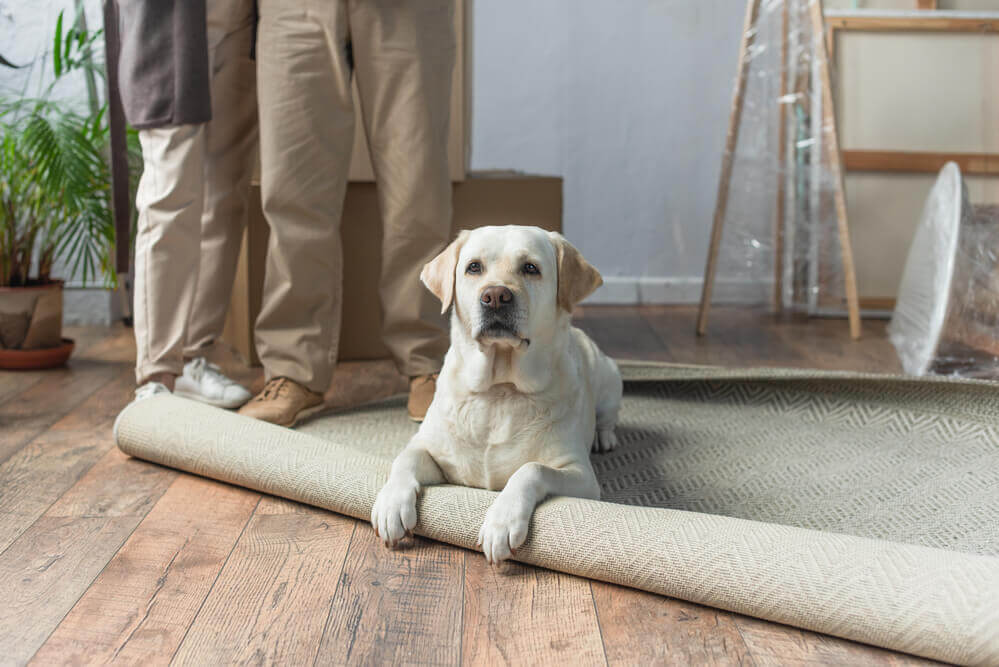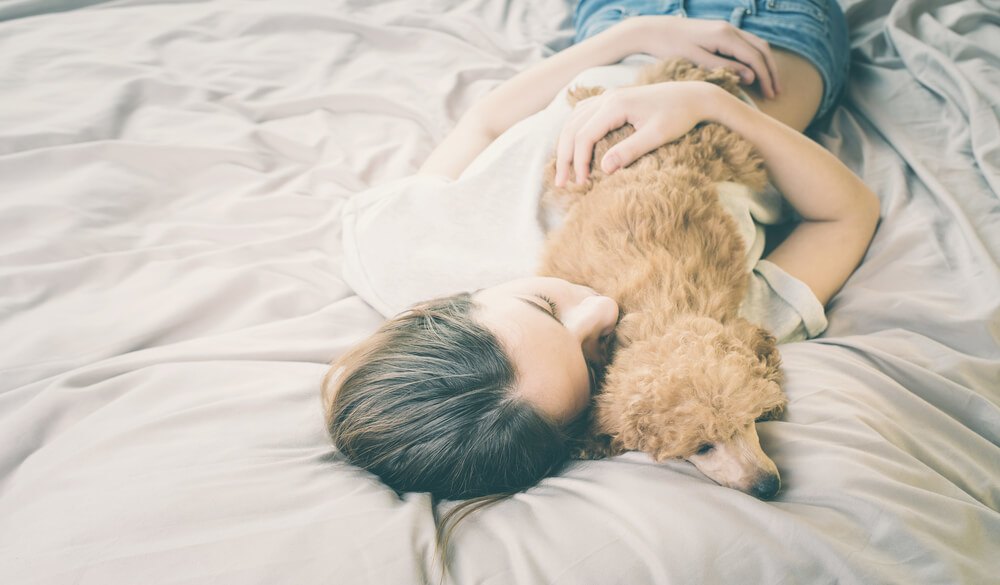Moving to a new house with a dog is an exciting and stressful time for both dogs and their owners alike. Luckily, there are some things that we can do to help our dogs adjust to a new home.
When moving with a dog it is a good idea to take extra steps to help your dog adjust. If you have a dog that is anxious about big changes like mine can be, then having some ways to soothe their nerves is a good idea.
Here's a complete guide on how to help a dog adjust to a new home. Our tips and step-by-step processes should make moving with dogs as stress-free as possible.

When moving your dog into a new home, they will most likely feel insecure or feel stress.
How Long Does it Take For a Dog to Adjust to a New Home?
Most dogs are fairly resilient and adjust to their new home within a couple of weeks.
This is even when the dog is on the more anxious side. Of course, there are things that dog owners can do to make the transition more seamless for both their dogs and themselves.
Following our 7 tips on moving with dogs to a new home.
7 Tips On How to Move With a Dog and Acclimate a Dog to a New Home

Stress-related behaviors stemmed by a move can range from being fearful, sad, vocal, destructive, depressed, ill-mannered, and even aggressive.
Moving house can be a long process that starts even before we start packing boxes.
Here are our 7 expert tips on how to move house with your dog in the easiest way possible.
1. Get Logistics Figured Out Before the Move
You may need to make some changes like switching doctors and schools when moving to a new house. Well, you will likely need to do this for your dog as well.
Here are some logistical things that you should have figured out before actually moving with pets.
- Your dog’s new vet office
- Updating your dog’s microchip information
- Having updated tags on your dog’s collar
- Have all of your dog’s paperwork in one place (Vaccination records, health history, etc.)
Having these things figured out ahead of time will allow you to worry about other things when moving time comes. It is also important to have your dog’s paperwork all in one place. This is because many landlords and apartments will want to see this information.
2. Explore Your New Neighborhood

If you are moving with your dog, bringing your dog to the new home for a brief visit before the move can help your dog familiarize with their new environment.
Exploring your new neighborhood with your dog can be a fun way to acclimate them.
Of course, this step is only applicable if you are moving to a new home close by. Going to explore a few times before actually moving will help your dog to get more comfortable with the new sights and sounds.
3. Have a Safe Space Set Up for Your Dog
It is important to have a safe and comfortable space set up for your dog throughout the moving process.
Having a space set up with your dog’s bed, some toys, a blanket, and any other comfort items will help the relax. Having their crate also set up with some of these items is also a good idea.
4. Remember to Take Fun Breaks
Moving can be stressful, so taking fun breaks with your dog can help both of you loosen up a bit.
Remembering the time to visit the park and go for fun walks will help your dog reset and let loose for a while. It will be nice for you to take a break from the stresses of moving as well.
5. Take Measures to Help Your Nervous Dog Adjusting to New Home

Help rescue or adopted dogs adjust and relax in their new home by being prepared and adjusting your expectations.
There are some measures that dog owners can take to help their dogs adjust to a big change like moving house.
Here is a step-by-step guide on how you can help your dog adjust to their new home.
Step 1: Don’t Pack Everything up Right Away
Dogs tend to get stressed out when we take out suitcases and boxes to pack.
Even though you may have the urge to get packing done within just a few days, packing more slowly will help your dog adjust.
Try to begin by just packing a handful of boxes to start off with. Then slowly add more boxes over the next couple of weeks. This will allow your dog to get used to small changes over time rather than one very big change.
Big changes tend to affect dogs more, especially more anxious ones.
Step 2: Consider Having Your Dog Go on a Fun Sleepover During Big Packing and Moving Days
It can also be a good idea to let your dog have a fun sleepover when moving. This can be especially beneficial on the days you finish packing and move your items to your new home.
Preferably this will be a place that your dog has been to before and is comfortable in. A friend's or family member’s house is a great option. Familiar pet sitters are great as well.
Doing this will allow your dog to relax during the most stressful parts of moving. It will also have your dog out of the house during the potentially hazardous act of moving furniture and heavy boxes.
If you cannot make these kinds of arrangements, don’t worry! You can also keep your dog in a secure and comfortable space. Their crate or a closed-off room will work.
Step 3: Set up Your Dog’s Safe Space in the New House
It is best to have a safe space set up for your dog first thing. This space can have their crate, bed, toys, and comfort items. It is also a good idea to have some items there that smell like your old house.
This will help get your dog started off on the right foot.

Don't think that your dog requires a new bed, blankets or toys because of the move, it's important bring all your dog's favorite things from the old home that your dog is familiar with.
6. Consider Medications and Products That Help Get Dogs Through Anxiety
Some dogs get very anxious when there are changes to their environment. If this sounds like your dog, then it is a good idea to have some items ready.
Thundershirts are a great way to calm dogs down. You may also want to speak with your vet about anti-anxiety medication and if your dog is acting different after moving.
7. Set Up Your Dog’s Sleeping Area in the New House

Provide your new dog with his own comfy bed or safe spot where he can retreat to during this adjustment period.
Setting up a safe space for your dog to sleep is crucial in the first few weeks in a new home.
Here is a step-by-step guide to setting up your dog’s sleeping area.
Step 1: Choose a Spot That is Close to You at First
Though not everyone has their dog sleep in their bed, having your dog in the same room as you can be very beneficial.
This will help them feel more comfortable and secure at night in the new home.
You can do this by putting your dog’s bed or crate in a place in your room where they can still see and smell you.
Step 2: Set up Your Dog’s Sleeping Area
Next, make your dog’s sleeping area calm and relaxing. Place their bed and some blankets in their area.
It is a good idea to keep this as similar as possible to their old sleeping arrangements. It is also a good idea to have some comfort items that smell like their old home.
Step 3: Slowly Increase the Distance Between You and Your Dog at Night
This step is mainly for those who would like their dog to sleep in a different room.
Slowly increasing the distance between you and your dog at night will make the transition less jarring to them.
This is a good idea to do, even if your dog slept in a separate room from you in their old home.



